We are talking about the modernization of our tanks for SVO, and when will we change their shells?
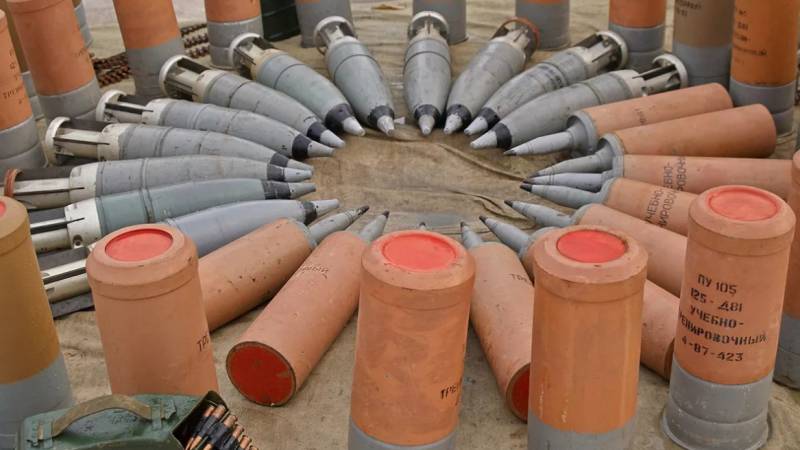
Source: tvzvezda.ru
Since the beginning of the special military operation in Ukraine, thousands, if not tens of thousands of comments on how to modernize our Tanks taking into account modern realities. Either they say about the mandatory equipping of combat vehicles with an active protection complex, or the presence drone on the tank are erected at the forefront. You can’t count all the rationalization proposals, but for some reason they somehow abruptly forgot about the shells. And for them, specifically high-explosive fragmentation, it is high time to retire. Especially when there is an alternative.
When a high-explosive fragmentation projectile is as important as a sub-caliber one
In general, the ammunition load of our tanks is quite interesting. In fact, it consists of as many as three types of armor-piercing ammunition, which includes feathered sub-caliber and cumulative projectiles, as well as guided missiles launched through a cannon barrel. But there is only one projectile that can effectively deal with enemy manpower, fortifications and unarmored (or lightly armored) equipment - high-explosive fragmentation (OFS). Yes, you can shoot at the same buildings and structures with sub-caliber ones, and for lack of a better one, a cumulative one is also suitable for infantry, but the OFS is the king here - the king of wars of the last decades.
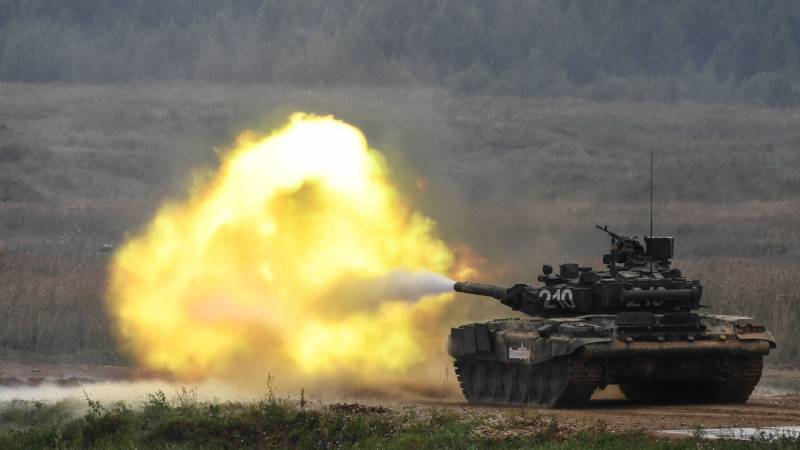
Source: ianed.ru
We participated in the Afghan war, followed by Chechnya, and then Syria. And no conflict from this list was marked by some too significant head-on tank battles - such episodes were rather rare. However, one can reasonably object: all these wars were fought against semi-partisan formations, therefore, in principle, there could not be tank battles there.
But on February 24, 2022, a special military operation began on the territory of Ukraine. An enemy with a fairly large armed forces with several hundred tanks and a bunch of other armored vehicles. And ... large-scale or at least frequent battles of tanks against tanks again did not happen.
Again, as in the last 30-odd years, the same tasks are set before the tankers. In urban conditions - the suppression and complete destruction of enemy strongholds in buildings and other structures. In the field - again, the suppression and destruction of strongholds, the grinding of positions and the breakthrough of defense, or vice versa - its provision. And, as it becomes clear, high-explosive fragmentation shells in these conditions play a dominant role.
The author does not have detailed information about the shells consumed by our troops, but even offhand, the consumption of high-explosive ammunition in tank units exceeds the rest of the ammunition ten times, if not more.
And what is the problem?
And the problem is that the design and principle of operation of regular tank high-explosive fragmentation shells have long been outdated. Not really unnecessary trash, you can fight, but the fact of the presence of flaws is obvious.
And you need to start, as usual, for health, and for peace later.
The undoubted advantage of OFS is the ability to break through walls, parapets and other obstacles. He moved the fuse valve to the closed position, installed the protective cap - and shoot at the enemy's sheltered manpower. The very thick walls of some reinforced concrete bunkers will not be mastered the first time - it would be desirable to first break through a gap with a sub-caliber projectile, or in general it will be limited to them alone - but for most tasks of this type it will be enough. Here you can give an example of "Azovstal" in Mariupol, when the tanks actually became the main armored "sledgehammer", which could somehow smoke out the enemy who had settled there.
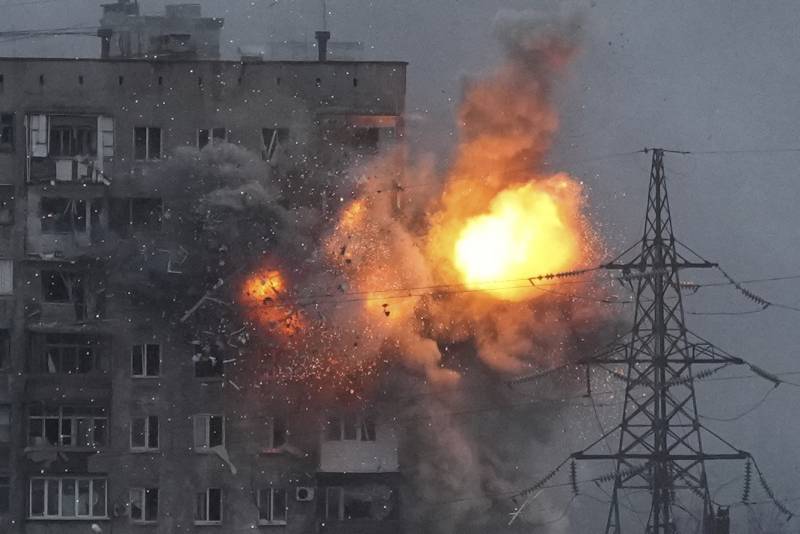
Shooting at the enemy who had settled in buildings became the main work of tanks in urban conditions in the NVO zone. Source: sila-rf.ru
But in open space, when only trenches and dispersed manpower are in the gunner’s sight, or, as a particular example, the positions of anti-tank missile systems, some problems begin. And sometimes such that even a fortified bunker will be easier.
It can be quite difficult to hit infantry in the trenches with a high-explosive fragmentation projectile, given the fact that it is well protected from the impact of fragments. Therefore, here, in order to destroy the enemy with a high degree of probability, especially at decent firing distances, you need either a direct hit in the trench, or next to it. And it's good if these positions are on some elevation - then it will be easier to hit them. And if the terrain is like an ironing board?
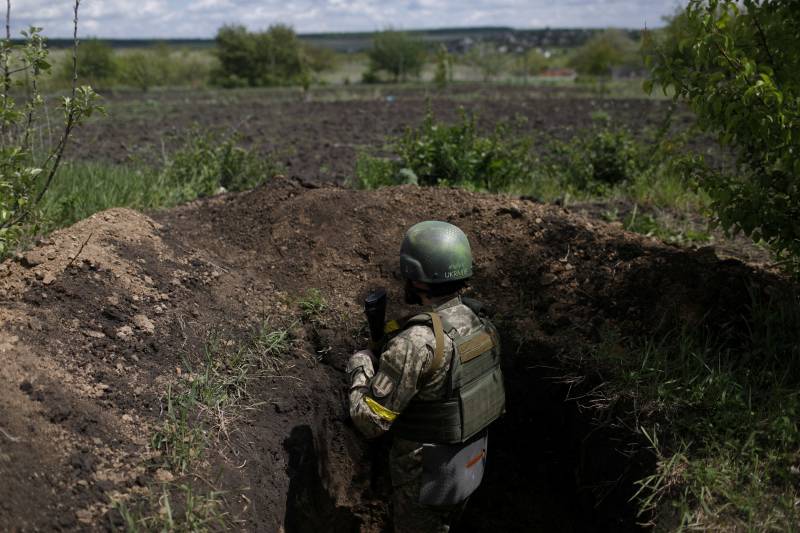
Infantry in the trenches is a difficult target for a tank. Source: news.myseldon.com
In one of the previous publications about the 152-mm cannon for a tank, we already cited as an example one of the episodes of the Chechen campaign, when the enemy infantry was behind the parapet, and the tankers had to try hard to hit it. Shot - the projectile flew over, shot again - undershot. They would have suffered so if it were not for the tree growing next to the parapet. They gave high-explosive fragmentation in his crown, then the enemy was covered from above.
With open manpower, including ATGM calculations, there are also difficulties. And it is not always easy to hit targets of this type with machine gun weapons. This topic generally requires a separate material, but in short it can be said: in most cases, preference will be given to a cannon, rather than machine guns.
First, as in the case of trenches, it is not always possible to adequately estimate the range to such targets, even with the help of a tank's laser rangefinder. Well, if the distance does not exceed the range of a direct shot, but what if more? Experienced and seasoned gunners will cope faster, but what if we are talking about "average"? One shot, two, three?
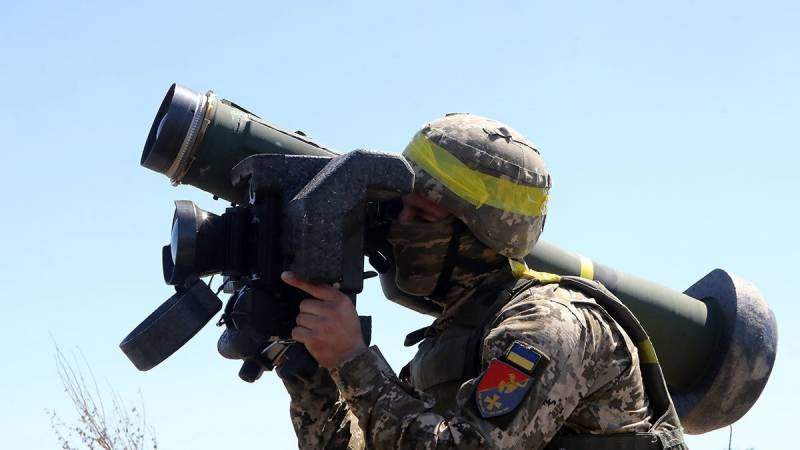
Anti-tank missile systems, especially man-portable ones, are among the most difficult targets for a tank. Source: trmzk.ru
Secondly, a regular high-explosive fragmentation projectile does not have the highest lethality in open space. The fact is that under these conditions, the fragmentation field formed by the projectile comes to the fore, but the energy of the explosion plays a secondary role.
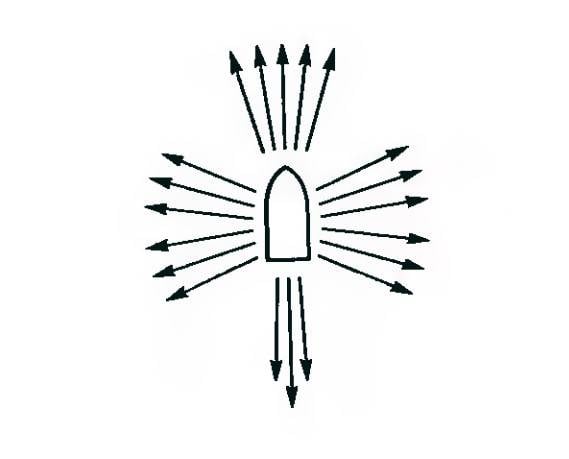
The direction of the flow of fragments during the static detonation of a high-explosive fragmentation projectile. Source: Means of Destruction and Ammunition. A. V. Babkin, V. A. Veldanov and others.
And with a fragmentation field, everything is just not very good. Since the OFS has a cylindrical shape, the largest number of fragments scatters perpendicular (or so) to its axis, therefore, when a projectile hits a surface (the ground, and so on), a significant part of the lethal elements goes either into the ground or up.
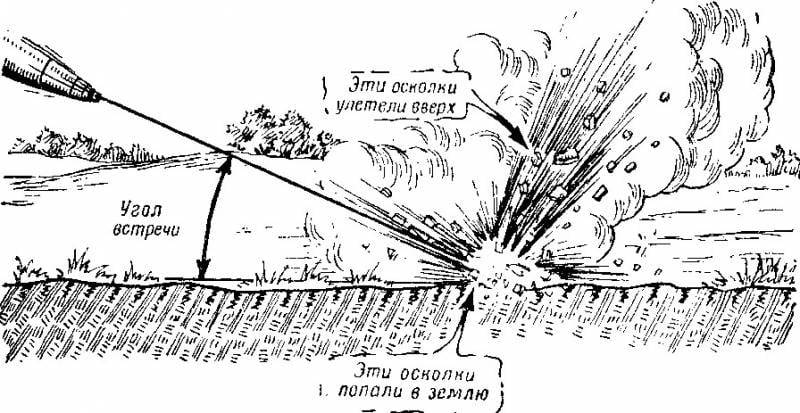
Schematic representation of the escape of fragments into the ground and up when the projectile is detonated. Source: topwar.ru
Because of this, the zone of actual destruction, although it seems large - depending on the angle of arrival, it can reach 60 meters wide and 20 deep and even more - but in fact the fragmentation field is distributed “crosswise” with large gaps, that is, the anti-personnel capabilities of the projectile are not as big as you would like. Guaranteed to cover the enemy without an exact hit will not always work, and an exact hit, as we noted above, is still a problem.
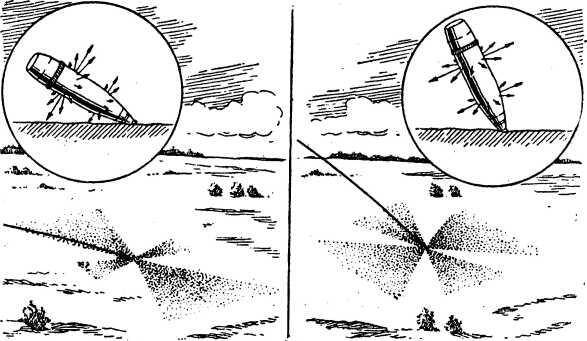
Schematic picture of the distribution of the fragmentation field of the projectile depending on the angle of its incidence. Source: www.dzen.ru
There is an alternative to high-explosive fragmentation
What conclusion can be drawn here? What projectile is required?
To effectively defeat the enemy’s manpower, both openly located and in the trenches, he must be able to air blast, since only from above can the largest area be tightly covered with fragments / striking elements. At the same time, the projectile should also work as a standard OFS, that is, be able to break through the walls of fortifications and buildings.
It is noteworthy that we have progress in this matter, and even of a serial nature.
Suffice it to recall the widely advertised Ainet system at the time, which was equipped with the T-90 and T-90A tanks, as well as the T-80UK. And speaking from a financial, industrial, nomenclature and other points of view, its implementation requires relatively lower costs, since the shells themselves do not need to be changed - it is enough for a standard OFS to screw on the 3VM-12 electronic fuse. Although, if we are talking about a total redesign of all tanks for this system, it will be necessary to make changes to the fire control complex, including through the introduction of an automatic time interval setter and related systems.
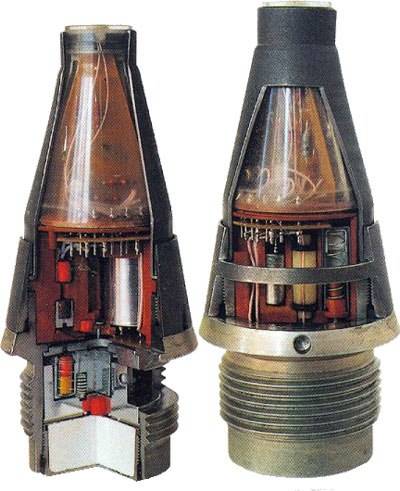
Electronic fuse 3VM-12 of the Aynet system for installation on regular OFS. Source: odetievbrony.ru
In the work of "Aynet" is not so complicated. The gunner measures the range to the target, after which the time is calculated for which the projectile will reach the enemy. It, with the help of the time interval setter, is set to the fuse in automatic mode in the process of loading a shot into the cannon. After leaving the gun, the projectile, according to the specified timing, detonates in the air above the target, covering a large area with a dense cloud of fragments. Thus, the density and other characteristics of the fragmentation field are almost tripled, and the cost of projectiles per target is reduced by half.
As an alternative to the regular use of OFS, it is quite suitable. But there are also disadvantages. "Aynet" is extremely sensitive to changes in the range to the target. From the moment the distance is measured until the shot is fired, the tank must stand still, otherwise, when it moves forward or backward, the distance will also change, and the Ainet does not automatically react to such changes. Also, the laser rangefinder has an error of plus/minus 10 meters, which can play a cruel joke when trying to destroy the enemy in the trenches - the projectile will explode either in front of the trenches or behind them without causing damage to the enemy. There are no questions about the destruction of open infantry.
A better, but at the same time expensive option for replacing regular OFS looks like 3OF82 "Telnik". This is already a radically modernized high-explosive fragmentation projectile, which in its design is significantly different from the standard ones.
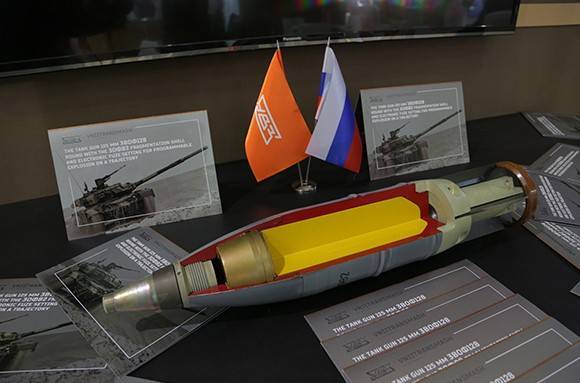
High-explosive fragmentation projectile with ready-made striking elements "Telnik". Source: topwar.ru
At first glance, it really stands out for nothing, but its “inside” does not look like a standard one at all. So, the mass of explosive in this product was reduced to 3 kilograms, due to which an additional volume was released in the bow, which was filled with a block of ready-made striking elements (GGE) in the amount of 450 pieces. The head part of the projectile, instead of a standard fuse, is equipped with a remote contact under the marking 3V48.
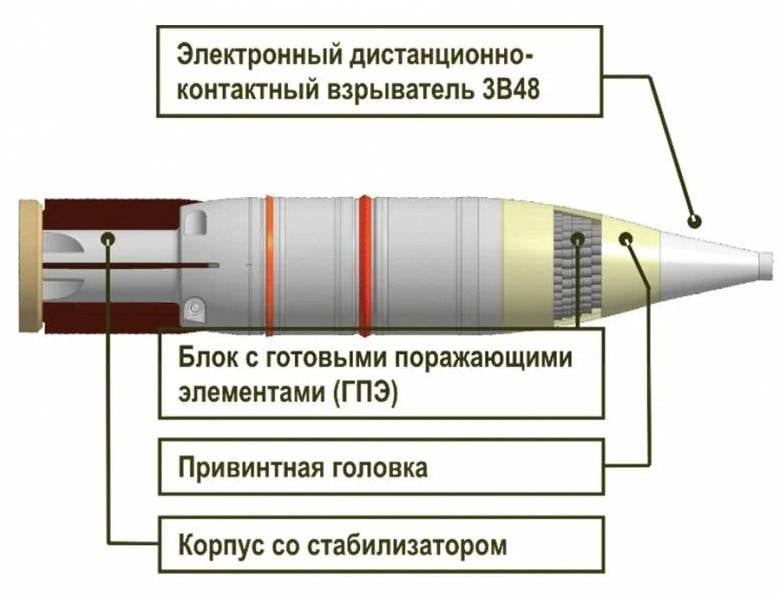
Schematic representation of the Telnik projectile. Source: topwar.ru
The fuse is programmed similarly to the Ainet process - the distance to the target is measured and the corresponding values are set automatically. But, given the presence of a block with ready-made striking elements, Telnik has the functionality to detonate in front of the target, and not above it, thereby covering a circle of almost 42 square meters only due to the GGE. But during the explosion, the body is also crushed, showering fragments of a huge territory. Thus, errors in measuring the distance to the target are leveled. All this allows you to increase the anti-personnel capabilities of the tank by 6-8 times. Looks interesting at least.
Unlike "Ainet" with its regular OFS, but with a new fuse, "Telnik" can detonate both directly above the target and in front of it. In addition, all other functions of the standard projectile are retained. Depending on the setting of the fuse, the contraption is capable of exploding both instantly upon impact with the surface, and with a small or large slowdown to overcome the walls of fortifications, buildings, and other things.
Absolutely all tanks with a 125-mm gun can shoot the Telnik, but after making appropriate changes to the fire control complex and installing fuse programming systems. There was information that this option is already available by default in the T-90M, but there is no real confirmation of this in the public domain.
Conclusions
What can I say? The fact that an ordinary high-explosive fragmentation projectile, like a hollow blank with explosives inside, is not at all universal and far from ideal against infantry, was known a long time ago, and not even 30 or 40 years ago. And time after time we step on this rake. A new armed conflict begins, and there - this has never happened, and here again - the infantry becomes the main enemy of the tank.
Perhaps these projectiles have already earned some fair attention, in contrast to missiles launched through the barrel, which sometimes have an exclusively decorative function?
There is no doubt that "Telnik" and, in particular, "Aynet" technologies are actually ancient and not the most effective. But even their widespread introduction will reduce the consumption of ammunition per target by at least two times or more. And a lower consumption is not only a greater number of shells left in the tank’s ammo rack, but also a shorter time to hit a target and a lower chance of getting a response, which, of course, will increase the survival of tankers on the battlefield.
Of course, such questions cannot be simply solved. Fundamental changes are required in the fire control systems of tanks and the range of ammunition, if we are talking about Telnik, which are not done at the snap of a finger. But you shouldn’t put these problems aside either - not everything with dynamic protection and sub-caliber shells can be solved on the modern battlefield.
Information